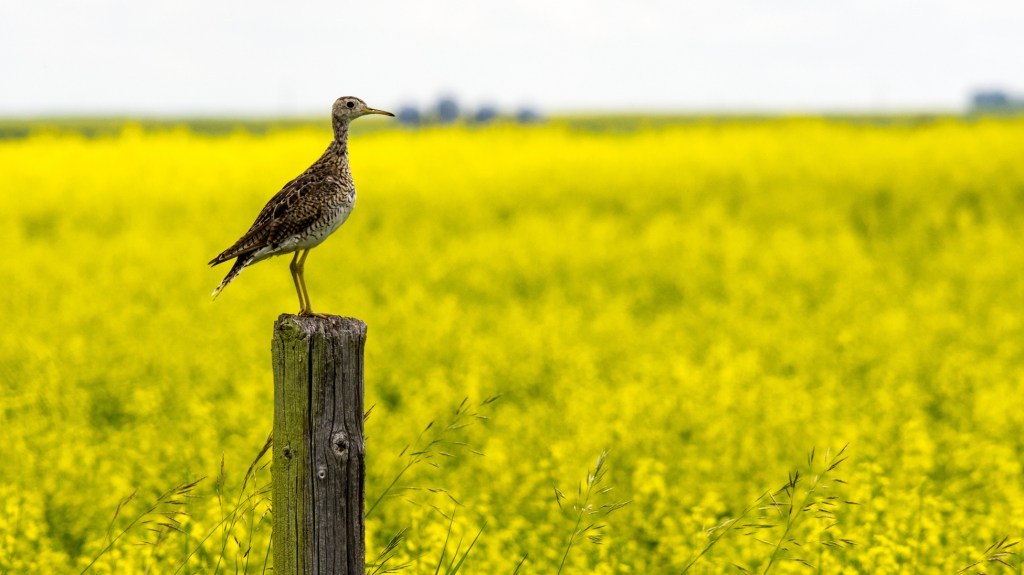What’s the effect of cattle grazing on grassland birds? It may not be what you expect.
Cows and grassland birds have at least one thing in common: they both have a bit of an image problem.
Cattle grazing is sometimes seen as detrimental to biodiversity and habitat, and grassland birds are not the flashy, colorful species of the tropics. In fact, many refer to grassland birds as LBJ’s (little brown jobs).
Even though the beauty of grassland birds is definitely of the understated variety, they remain iconic sights and sounds in our disappearing North American grasslands where cattle grazing is often the dominant land use.
As a fan of the underdog in life, I find myself a champion for the plight of grassland birds, and this led me to conduct a study on grassland birds and grazing in the tallgrass prairies of southeast North Dakota with my coauthor, Dr. Christopher Merkord.
Despite concerns that cattle grazing could be detrimental, we found that, in fact, grassland birds and cows can be friends. Cattle grazing generally increased the abundance of Grasshopper Sparrows (Ammodramus savannarum), Upland Sandpipers (Bartramia longicauda) and Bobolinks (Dolichonyx oryzivorus), and variation in grazing intensity supported variation in bird community composition across the landscape.

In this study, we had a unique opportunity to use Nature Conservancy land surrounded by federally owned National Grassland to evaluate how reduced grazing pressure on Conservancy land might impact the overall grassland bird community across the study area.
Conducting fieldwork is my favorite part of my job. Hiking across the prairie at dawn, enjoying the sunrise in the cool morning air and taking in the dawn chorus of songbirds renews my passion for conservation every year. However, in field studies you have to be ready for a curve ball from Mother Nature, and this one was no different. We surveyed the birds and collected habitat data over a three-year period.
To survey the birds, we walk to randomly assigned GPS points in each pasture and spend 5 minutes at each point recording and counting all the birds we see and hear. The first year of surveys was extremely wet. Some of our points became islands in a sea of rising wetlands and life jackets were almost necessary to walk across the prairie. The second two years were extremely dry; where last year we donned chest waders we now tromped across crunchy, dry cattails. Being in the field over these three years was a good reminder of the annual variability inherent in grassland ecosystems.

What we learned from these three years is that weather patterns can influence grassland bird communities as much or more than the management actions we take. In the first year, the grassland bird community was more heavily represented by wetland and wet prairie associated species like Yellow-headed Blackbirds and Sedge Wren, while dry prairie associated species like Grasshopper Sparrows increased in the second two years.
However, despite the extreme weather variability across years, cattle grazing still showed a positive influence on three of our four focal species. Perhaps even more importantly, the habitat created by reducing grazing pressure on Conservancy lands did support a different bird community than the federally managed National Grasslands.
Why does this matter? Most of the remaining grassland in the U.S. is in private ownership and is grazed. Our results suggest two encouraging patterns for grassland bird populations in these private landowner dominated landscapes.

The first is that the grazing intensities used on the National Grassland, which are similar to private livestock production operations, are not necessarily harming grassland bird populations. The second relates to a common practice in cattle production referred to as ‘take half, leave half.’ Many landowners abide by this ethic, which creates a lot of grassland that structurally looks the same.
Our results suggest that conservation organizations could potentially increase the grassland bird community supported on the landscape by creating structurally different habitat on their lands. In our case, reduced grazing pressure increased the height, litter and density of the grassland habitat and supported a greater abundance of the species that prefer this type of habitat.




Good to know and would have expected higher utilization in native grassland. However, in introduced, none native grassland, the majority not under rotational grazing found in the Southeast U.S. , far fewer songbirds would benefit.
I love that. I’m a person who trying to combine nature – livestock and have many questions about that. If it possible, would love to have adviser on that matter. Thanks. Lhagva to be a farmer, eastern steppe, Monngolia